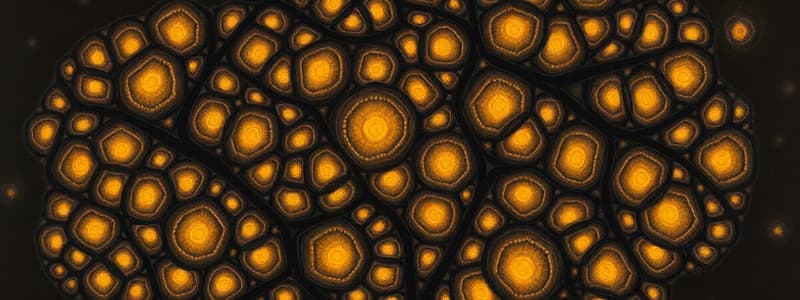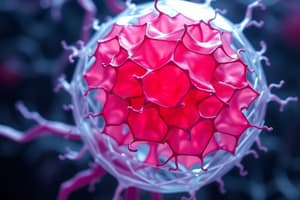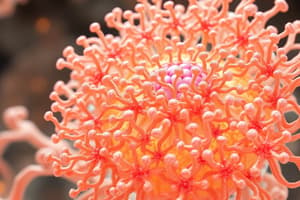Podcast
Questions and Answers
What is a primary function of the smooth endoplasmic reticulum (SER)?
What is a primary function of the smooth endoplasmic reticulum (SER)?
- Protein synthesis for the nucleus
- Lipid synthesis, especially steroids (correct)
- DNA replication within the cell
- Transporting waste out of the cell
What is the typical appearance of the Golgi apparatus in secretory cells when viewed under a light microscope with H&E stain?
What is the typical appearance of the Golgi apparatus in secretory cells when viewed under a light microscope with H&E stain?
- Uniformly stained with no distinct features
- Uniformly granular with high density
- Dark structure with irregular shapes
- Clear area in the cytoplasm near the nucleus (correct)
Which of the following cells is most likely to have a well-developed rough endoplasmic reticulum?
Which of the following cells is most likely to have a well-developed rough endoplasmic reticulum?
- Neurons (correct)
- Adipocytes
- Liver cells
- Muscle cells
Which of the following describes the composition of the Golgi apparatus?
Which of the following describes the composition of the Golgi apparatus?
What distinguishes the rough endoplasmic reticulum (RER) from the smooth endoplasmic reticulum (SER)?
What distinguishes the rough endoplasmic reticulum (RER) from the smooth endoplasmic reticulum (SER)?
Which function is NOT associated with the smooth endoplasmic reticulum?
Which function is NOT associated with the smooth endoplasmic reticulum?
What function does the Golgi apparatus serve in relation to proteins?
What function does the Golgi apparatus serve in relation to proteins?
What is the role of the Golgi apparatus in the cell?
What is the role of the Golgi apparatus in the cell?
How are lysosomal enzymes activated?
How are lysosomal enzymes activated?
Which of the following cells would be most active in glycogenolysis?
Which of the following cells would be most active in glycogenolysis?
Where are lysosomes formed within the cell?
Where are lysosomes formed within the cell?
What appears as membrane-bound tubules and vesicles with no ribosomes?
What appears as membrane-bound tubules and vesicles with no ribosomes?
What is a primary feature of primary lysosomes when viewed under an electron microscope?
What is a primary feature of primary lysosomes when viewed under an electron microscope?
Which cells are likely to contain a higher abundance of lysosomes?
Which cells are likely to contain a higher abundance of lysosomes?
What is a characteristic feature of secretory cells in relation to the Golgi apparatus?
What is a characteristic feature of secretory cells in relation to the Golgi apparatus?
What is one of the functions of the Golgi apparatus in relation to carbohydrates?
What is one of the functions of the Golgi apparatus in relation to carbohydrates?
Which type of synovial joint allows for motion in two planes?
Which type of synovial joint allows for motion in two planes?
What factor contributes most to the stability of joints?
What factor contributes most to the stability of joints?
In a ball-and-socket joint, which component fits into the concavity of the socket?
In a ball-and-socket joint, which component fits into the concavity of the socket?
Which of the following joints is an example of a pivot synovial joint?
Which of the following joints is an example of a pivot synovial joint?
What type of movement is limited by tension in the ligaments?
What type of movement is limited by tension in the ligaments?
Which joint type is best exemplified by the carpometacarpal joint of the thumb?
Which joint type is best exemplified by the carpometacarpal joint of the thumb?
Which of the following factors does NOT limit joint movement?
Which of the following factors does NOT limit joint movement?
What is characteristic of bi-axial synovial joints?
What is characteristic of bi-axial synovial joints?
What are nutrient canals responsible for in bone development?
What are nutrient canals responsible for in bone development?
Which statement best describes membranous bones?
Which statement best describes membranous bones?
What initiates the primary ossification center in the bone model?
What initiates the primary ossification center in the bone model?
What are epiphyses in the context of bone development?
What are epiphyses in the context of bone development?
Which type of ossification occurs in the development of long bone models?
Which type of ossification occurs in the development of long bone models?
Which cells are responsible for the formation of the cartilage model in bone development?
Which cells are responsible for the formation of the cartilage model in bone development?
What happens to the bone matrix during hypertrophy of chondrocytes in the epiphysis?
What happens to the bone matrix during hypertrophy of chondrocytes in the epiphysis?
Which statement is true about the growth of long bones?
Which statement is true about the growth of long bones?
Which intermediate filament protein is primarily found in epithelial cells?
Which intermediate filament protein is primarily found in epithelial cells?
Which of the following intermediate filaments is unique to neurons?
Which of the following intermediate filaments is unique to neurons?
Which intermediate filament is associated with the maintenance of nuclear shape?
Which intermediate filament is associated with the maintenance of nuclear shape?
Desmin is an important protein found in which type of cells?
Desmin is an important protein found in which type of cells?
What role does vimentin play in cellular structure?
What role does vimentin play in cellular structure?
Which class of intermediate filaments is involved in the differentiation process of skin epidermal cells?
Which class of intermediate filaments is involved in the differentiation process of skin epidermal cells?
Which intermediate filament is specifically expressed in neural stem cells?
Which intermediate filament is specifically expressed in neural stem cells?
What is the composition of ribosomes?
What is the composition of ribosomes?
Flashcards are hidden until you start studying
Study Notes
Smooth Endoplasmic Reticulum (SER)
- Appears as membrane-bound tubules and vesicles without ribosomes.
- Involved in lipid synthesis, including steroids, in cells like those in the adrenal cortex and testes.
- Plays a role in detoxification of drugs, particularly in liver cells.
- Aids in muscle contraction by regulating calcium ion (Ca2+) levels.
- Facilitates intracellular transport of molecules.
- Participates in glycogenolysis, a process that breaks down glycogen in liver cells.
- Contributes to mineral metabolism in the parietal cells of the stomach.
Rough Endoplasmic Reticulum (RER)
- Characterized by flattened cisternae with ribosomes attached to its membrane.
- Ribosomes on the RER synthesize proteins destined for the plasma membrane, extracellular environment, or specific intracellular organelles.
- Highly developed in active secretory cells, like pancreatic acinar cells, plasma cells, and neurons.
- Appears basophilic under a light microscope due to the presence of ribosomes containing RNA.
- Nissl bodies, the large basophilic structures in nerve cells, are composed of RER and free ribosomes.
- Exhibits membrane-bound cisternae with ribosomes and concentrated material within its lumen under an electron microscope.
- Often continuous with the outer membrane of the nuclear envelope.
- Functions as the site for production of membrane and secretory proteins.
Golgi Complex (Golgi Apparatus)
- Consists of a complex network of membrane vesicles and cisternae.
- Modifies and matures proteins and other molecules synthesized in the ER.
- Sorts proteins into specific vesicles for various cell functions.
- Well-developed in secretory cells that release proteins via exocytosis and cells synthesizing large amounts of membrane and membrane-associated proteins.
- Appears as a light-staining or unstained area near the nucleus under a light microscope.
- Shows up as a dark structure after silver or osmic impregnation.
- Located perinuclearly in nerve cells, between the nucleus and secretory surface in secretory cells, and scattered in the cytoplasm of liver cells.
- Exhibits a stack of flattened cisternae with dilated edges and small and large vesicles under an electron microscope.
- The stack of cisternae is curved, with convex and concave sides.
- Contains 3-8 cisternae per Golgi depending on the cell's activity.
- Smaller vesicles originating from the RER carry secretory material towards the formation surface.
- Functions in the condensation and packaging of proteins originating from the RER.
- Forms lysosomes by packaging hydrolytic enzymes.
- Adds carbohydrates to proteins, creating proteoglycans.
- Modifies protein molecules by adding specific chemical groups.
Lysosomes
- Small, membrane-bound vesicles rich in hydrolytic enzymes.
- Act as the digestive apparatus of the cell, degrading obsolete cellular components.
- Contain enzymes like nucleases, proteases, and phosphatases, which are active at an acidic pH (4.5-5.0).
- Maintains an acidic internal environment for hydrolysis through a hydrogen ion pump embedded in its membrane.
- Originate from the Golgi region, with their enzymes synthesized in the RER.
- Particularly abundant in cells with high phagocytic activity, such as macrophages and neutrophils.
- Appear spherical under a light microscope and can be identified using special histochemical methods for detecting their enzymes (e.g., acid phosphatase test).
- Show up as membrane-bound vesicles under an electron microscope.
- Primary lysosomes have a uniformly granular, electron-dense appearance.
Blood Supply of an Individual Bone
- Blood vessels enter and spread through the periosteum, the fibrous sheath surrounding the bone.
- Nutrient vessels penetrate the cortex of the bone, extending into the marrow.
- Nutrient canals provide passageways for these vessels.
Development of an Individual Bone
- The human skeleton is preformed in the fetus, but not initially as bone tissue.
- Two bone types are classified based on their preformed basis: membranous bones and cartilage bones.
Membranous Bones
- Outer skull bones and the clavicle are examples.
- Osteoblasts invade a membrane, forming a center of ossification where bone formation begins.
- Bone formation spreads from this center, eventually forming a complete bone plate.
Cartilage Bones
- Many bones, such as long bones, exist as cartilage models in the fetus.
- Cartilage models develop from mesenchyme during the fetal period, and bone gradually replaces most of the cartilage.
Endochondral Ossification
- Mesenchymal cells condense and differentiate into chondroblasts, forming a cartilage bone model.
- The cartilage calcifies with calcium salts in the mid-region of the model.
- Periosteal capillaries grow into the calcified cartilage, supplying its interior.
- These capillaries, along with osteogenic cells, form a periosteal bud.
- The capillaries initiate the primary ossification center, where bone tissue replaces most of the cartilage in the main body of the bone model.
- The shaft of a bone ossified from the primary ossification center grows as the bone develops.
- Secondary ossification centers appear in other parts of the bone after birth, forming the epiphyses.
- Chondrocytes in the middle of the epiphysis hypertrophy, and the bone matrix calcifies.
- Epiphysial arteries extend into the developing cavities, accompanied by osteogenic cells.
Synovial Joints
- Classified based on the number of axes of movement allowed.
Uni-Axial Synovial Joints
- Allow movement in one plane.
Hinge Synovial Joints
- Allow movement in one plane, similar to a door hinge.
- Examples include the elbow and knee joints.
Pivot Synovial Joints
- Permit rotation around a central axis.
- Examples include the proximal radioulnar joint and the median atlantoaxial joint.
Bi-Axial Synovial Joints
- Allow movement in two planes.
Condyloid Joints
- Have a rounded or curved surface in two directions.
- Example: metacarpophalangeal joint of the fingers.
Ellipsoid Joints
- Feature an elliptical convex surface articulating with an elliptical concave surface.
- Example: radiocarpal joint of the wrist.
Saddle Joints
- Possess one articular surface that is partly convex and partly concave, while the other surface is reciprocally concave-convex.
- Example: carpometacarpal joint of the thumb.
Multi-Axial Synovial Joints
- Allow movement in all three planes of space.
Ball-and-Socket Joints
- Characterized by a spherical head fitting into a concavity.
- Example: hip joint.
Stability of Joints
- Stabilized by several factors:
Bony Factor
- The shape of articulating surfaces contributes to joint stability.
- Example: the well-adapted fit between the head of the femur and the acetabulum in the hip joint.
Ligamentous Factor
- The strength of the fibrous capsule and surrounding ligaments play a crucial role in joint stability.
- They prevent excessive movement and protect against sudden stresses.
Muscular Factor
- Strong muscles surrounding a joint contribute to its stability.
Intra-articular Pressure
- The pressure within the joint capsule also helps stabilize the joint.
Factors Limiting Joint Movement
- Several factors limit the range of motion at a joint:
Tension in Ligaments
- Limits movement, as seen when attempting to extend the knee.
Contraction of Antagonistic Muscles
- Limits movement, as observed when flexing the hip with the knee extended.
Intermediate Filaments
- Fibrous proteins that provide structural support and mechanical stability to cells.
- Classified into six major classes:
Keratins (Cytokeratins)
- Present in all epithelial cells.
- Form large bundles (tonofibrils) that attach to junctions between epithelial cells.
- Accumulate during keratinization of skin epidermal cells.
Vimentin
- Found in most cells derived from embryonic mesenchyme.
Desmin
- A vimentin-like protein present in almost all muscle cells.
Glial Fibrillary Acidic Protein (GFAP)
- Found primarily in astrocytes, supporting cells of the central nervous system.
Neurofilament Proteins
- Major intermediate filaments of neurons.
Lamins
- Form the nuclear lamina associated with the inner membrane of the nuclear envelope.
- Help maintain nuclear shape, anchor chromatin to the nuclear envelope, and participate in nuclear assembly and disassembly during cell division.
Cytoskeleton
- Network of protein filaments that provides structural support, helps maintain cell shape, enables movement, and facilitates intracellular transport.
Ribosomes
- Abundant in virtually all cells, their number varying based on the level of protein synthesis activity.
- Tiny, non-membranous organelles (20 × 30 nm).
- Composed of two subunits: a small subunit and a large subunit.
- Functionally, a ribosome binds to a strand of mRNA and facilitates translation, the process of converting mRNA into a sequence of amino acids.
- Chemically, ribosomes consist of rRNA (ribosomal RNA) and proteins.
Studying That Suits You
Use AI to generate personalized quizzes and flashcards to suit your learning preferences.




